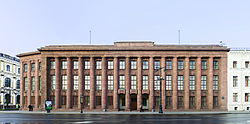
Back كلاسيكية مجردة Arabic Clasicismo despojado Spanish Classicisme dépouillé French Classicismo despojado Portuguese 简约古典主义 Chinese


Stripped Classicism (or "Starved Classicism" or "Grecian Moderne")[1] is primarily a 20th-century classicist architectural style stripped of most or all ornamentation, frequently employed by governments while designing official buildings. It was adopted by both totalitarian and democratic regimes.[A] The style embraces a "simplified but recognizable" classicism in its overall massing and scale while eliminating traditional decorative detailing.[3][4][5][6] The orders of architecture are only hinted at or are indirectly implicated in the form and structure.[B]
Despite its etymological similarity, Stripped Classicism is sometimes distinguished from "Starved Classicism", the latter "displaying little feeling for rules, proportions, details, and finesse, and lacking all verve and élan".[5][7] At other times the terms "stripped" and "starved" are used interchangeably.[8][9]
Stripped Classicism was a materialistic manifestation of 'political' modernism. Recent historiography has explicitly linked this architectural style – and its relationship with modernist thinking – to political projects arising in the 1920–1930s, which utilised artistic dexterity to articulate – in built form – a powerful political ethos orientated towards the future.[10]
Other writers have noted the need to read the impact of avant-garde movements such as the Italian Futurists, who extolled the innumerable possibilities of the modern world, on this unique style (and the futurism it espoused).[11] It was popularised by the French-born Paul Philippe Cret, among others, and employed in Nazi Germany, Fascist Italy, the Soviet Union and New Deal America.
- ^ Willingham, William F. (Spring 2013). "Architecture of the Oregon State Capitol". Oregon Historical Quarterly. 114 (1). Oregon Historical Society: 94–107. doi:10.5403/oregonhistq.114.1.0094. JSTOR 10.5403/oregonhistq.114.1.0094. S2CID 164151091. Jstor (subscription required)
- ^ Bryant 2011.
- ^ Sennott, Stephen, ed. (2004). Encyclopedia of Twentieth Century Architecture. New York: Fitzroy Dearborn. p. 269. ISBN 1579582435.
- ^ "Stripped Classical 1900-1945". Essential Architecture. Retrieved December 5, 2014.
- ^ a b c Cite error: The named reference
Curlwas invoked but never defined (see the help page). - ^ "Post War Stripped Classical". Archipaedia-archive. Archipaedia world architecture. November 23, 2009. Retrieved December 6, 2014.
- ^ Cf, Curl, James Stevens (2000). "Starved Classicism". A Dictionary of Architecture and Landscape Architecture. Encyclopedia.com. Retrieved December 6, 2014.
- ^ "Return To Classicism". chicagotribune.com. June 9, 1985. Retrieved April 18, 2018.
- ^ "Frist Center for the Arts, former US Post Office in Nashville". wordpress.com. October 4, 2015. Retrieved April 18, 2018.
- ^ Patterson, Samuel, "'Problem-Solvers': The Modernist Ethos Behind Architecture in Stalinist Russia and New Deal America"[1], 2019.
- ^ Patterson,"'Problem-Solvers'"[2], 2019.
Cite error: There are <ref group=upper-alpha> tags or {{efn-ua}} templates on this page, but the references will not show without a {{reflist|group=upper-alpha}} template or {{notelist-ua}} template (see the help page).